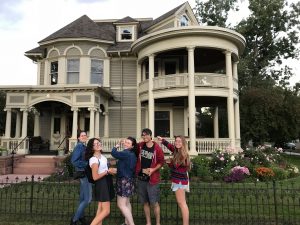Surprisingly, in the few short weeks I have been an Art History student, I find myself identifying art wherever I go. After a lesson focusing on Greek art, my fellow classmates and I were delighted to spot some Ionic columns on our way to dinner and asked a stranger to take a picture of us. We even decided to all stand in contrapposto when posing for another photo (see photos for examples of people getting way too excited about art).
Today, we learned about the history of Romanesque and Gothic architecture in European churches, and I was curious to find out if the style of CC’s own Shove Chapel could be related. After some research, I found out that it was designed by John Gray in a Norman Romanesque style, and was inspired by the Winchester Cathedral. This can be seen in its round arches framing the nave and in its very solid and simple appearance. Despite this, there are also hints of Gothic architecture found as well, particularly in the use of stained glass, examples of which can be seen beautifully displayed in the three large windows above the main entrance. This was intentional, as stated in a book titled, This Glorious and Transcendent Place, written by Timothy Fuller as a commemoration of the 15-year anniversary of the chapel. He writes, “Mr. Gray’s aim was to learn from the past, but not to imitate it slavishly. It is, he said, ‘a new expression based on an old model.’” He combined original design with inspiration from historical sources. So although the building is classified as Romanesque, it still has elements from other styles as well. Everyone at CC sees Shove Chapel on a regular basis, hence, they are also regularly experiencing art, whether or not they are aware of it.
Art comes in so many shapes and forms, from simple prehistoric wall paintings, to the incredibly detailed frescoes on the ceiling of the Sistine Chapel. Even if one hasn’t studied art or its history, it is important to acknowledge that art can be applied to the “real world,” and that it affects the every day human experience. Studying Art History has inspired me to seek out art in the “real world,” and it is a lot easier to find than one might expect.


